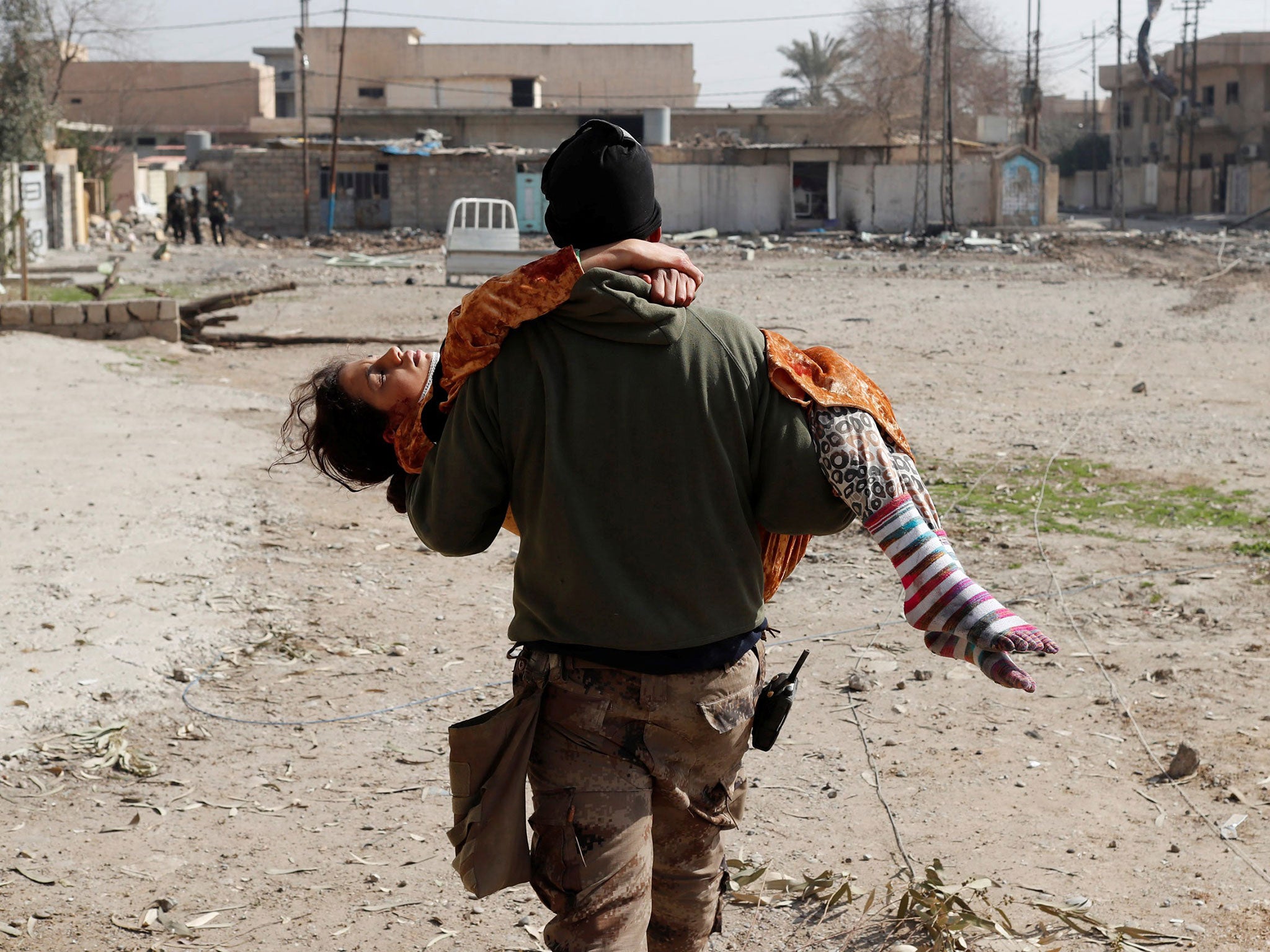Iraqi army nears Mosul's main government buildings as battle to oust Isis proceeds quicker than expected
Hardened by the long battle for east Mosul, government forces are making ground faster than hoped in the city’s west

Iraqi military forces are advancing towards the main complex of government buildings in the centre of west Mosul, indicating that Isis is losing control of its last big urban stronghold in Iraq.
“The provincial council and the governorate building are within the firing range of the rapid response forces,” said an officer with the elite interior ministry units.
The Iraqi government offensive is evidently making ground faster than had been expected against some 4,000 Isis fighters, besieged along with 750,000 civilians in the half of Mosul city to the west of the Tigris river. The aim of the multiple attack against this enclave is to keep Isis under pressure on all fronts so it will not have enough men to hold back the Iraqi security forces that far outnumber it. Isis is making very effective use of a mix of snipers, suicide bombers, mortars, bombs, booby traps and drones.
Iraqi forces say they have seized both ends of one of the five bridges spanning the Tigris, which have all been broken by US air strikes and Isis demolition teams, but could be made passable again by using pontoon bridging equipment supplied by the US.
People inside the city are running out of food, and there are reports that the old Sarj-Khana market has been burned by Isis. Militants are setting fire to private houses in order to create a smoke screen that will hide its fighters from the US-led air strikes which are clearing the way for ground troops.
The UN humanitarian aid office said on Tuesday that 8,000 people have fled to government-controlled areas south of Mosul since the latest Iraq military offensive began on 19 February and they “are often exhausted and dehydrated”.
The main weight of the attack so far is coming from the south and has captured the airport along with several districts of Mosul. Isis is likely to make its main stand in the close-packed residential housing and narrow alleys of the old part of Mosul. It took Iraqi security forces three months from 17 October last year to capture east Mosul during which they lost 500 dead and 3,000 wounded according to General Joseph Votel of the US Central Command.
Many of the most effective Iraqi units reportedly suffered over 30 per cent losses, though the Iraqi government in Baghdad refuses to disclose military and civilian casualties.
The recapture of Mosul by the Iraqi armed forces, which lost the city to a much smaller number of Isis fighters in June 2014, will be a crushing blow to the Caliphate that was declared at that time and at its height controlled territory the size of Great Britain. Its astonishing victories against superior forces in Iraq and Syria two-an-a-half years ago were portrayed by Isis as proof that it had divine assistance. Its string of defeats and shrinking territory since 2015 have had the contrary effect of persuading many Sunni Arab tribes and communities that the self-declared Caliphate is coming to an end.
The real situation in front line positions in and around west Mosul is unclear because the Iraqi government reports only successes and never mentions setbacks or defeats. They sometimes announce the capture of districts and towns long before government troops have reached them. The blog Musings on Iraq , which has published a detailed daily account of the 132-day campaign to take Mosul, complains that “the Iraqi forces’ (ISF) statements either by officers or even official ones have become so unreliable that they cannot be trusted unless pictures are posted on social media or a western reporter confirms them”.
Nevertheless, Iraqi forces do appear to have improved their tactics since the grinding street-to-street fighting in east Mosul, which they had expected to seize much more quickly. One significant development is that US soldiers advising and calling in air strikes are now positioned closer to the front line than they were last year. Aside from closer involvement of US troops in the fighting, the Trump administration has so far changed very little in operations against Isis initiated under President Obama.
General Stephen Townsend, the commander of the Combined Joint Task Force – Operation Inherent Resolve, says that since August 2014 the US-led Coalition “has conducted more than 10,000 air strikes against Isis targets in Iraq and trained and equipped more than 70,000 Iraqi forces to support Iraqi operations”.
Isis is under pressure on all fronts, including Syria, where it has lost the town of al-Bab to Turkish forces and Arab auxiliaries under their control. Isis commanders must also prepare for an assault on its de facto Syrian capital of Raqqa by the Syrian Democratic Forces, whose main fighting force is drawn from the Syrian Kurds operating in cooperation with the US air force and US special forces on the ground. Isis is beset on every side but is likely to fight to the end, which may be a long time coming.
Join our commenting forum
Join thought-provoking conversations, follow other Independent readers and see their replies
Comments